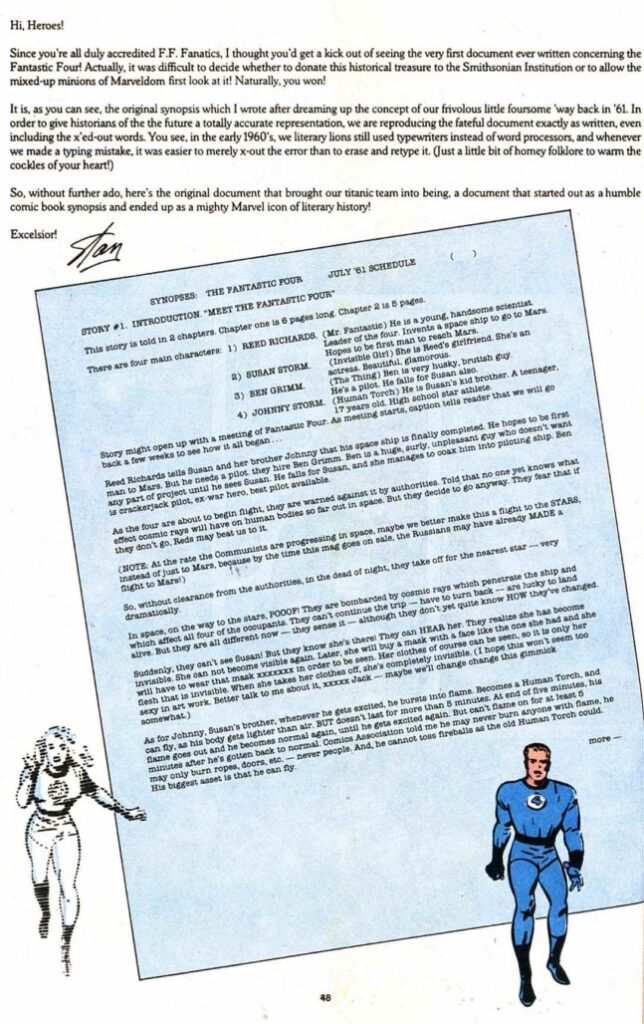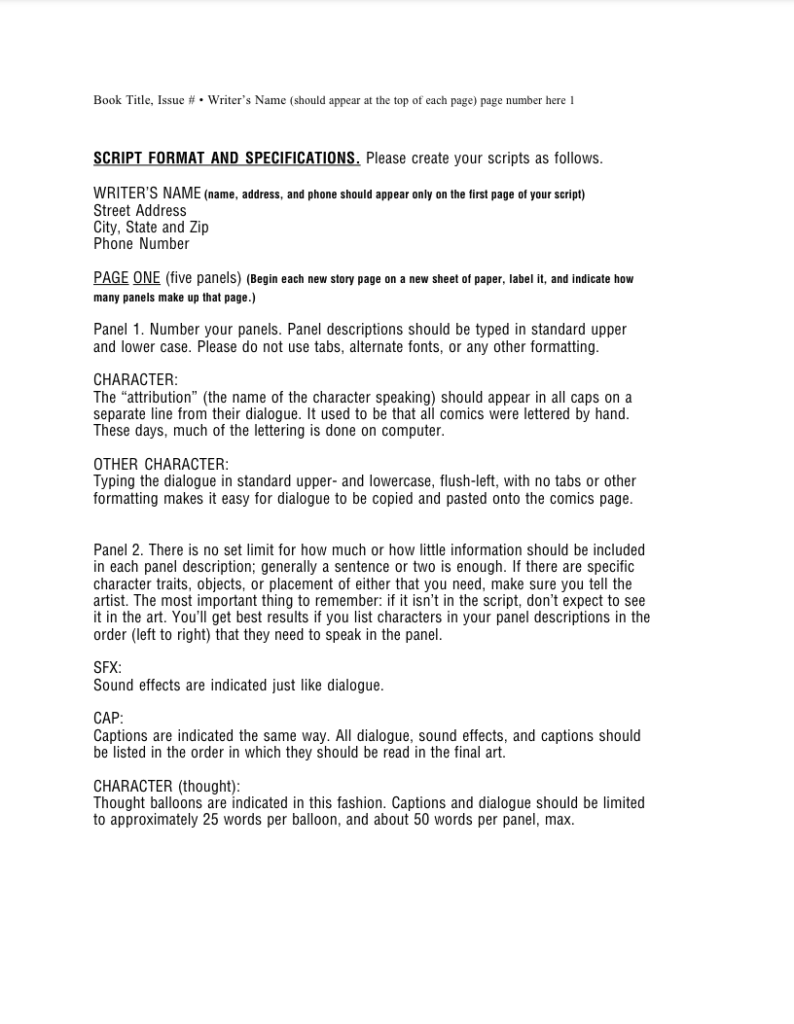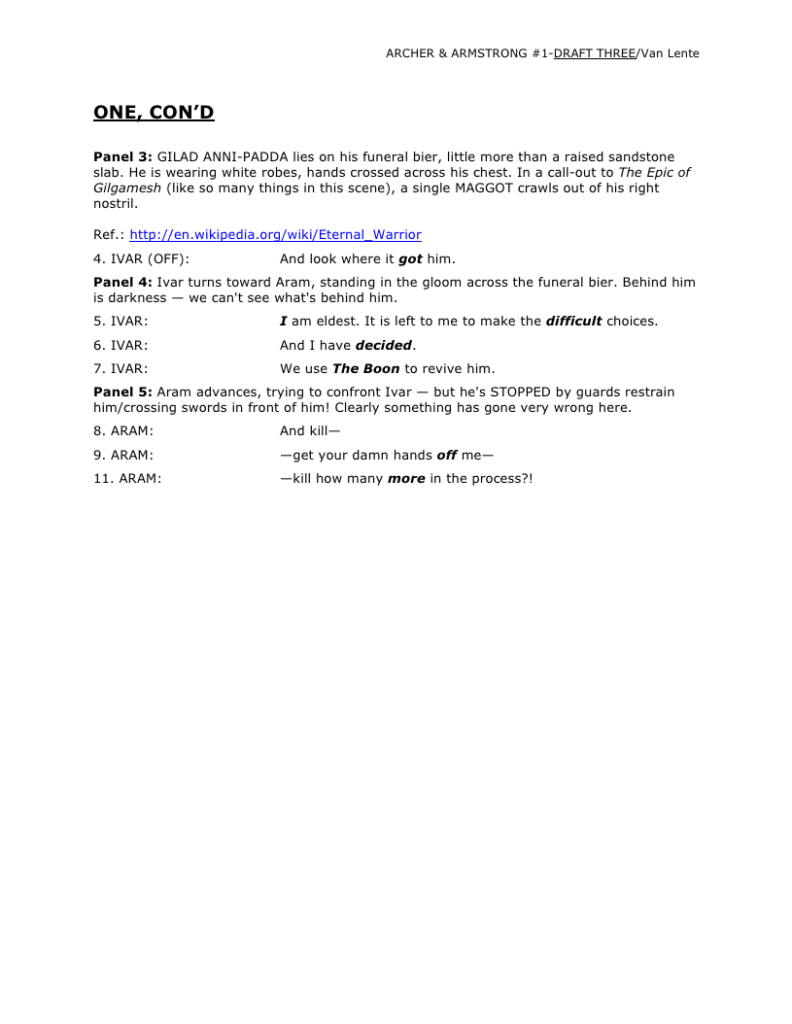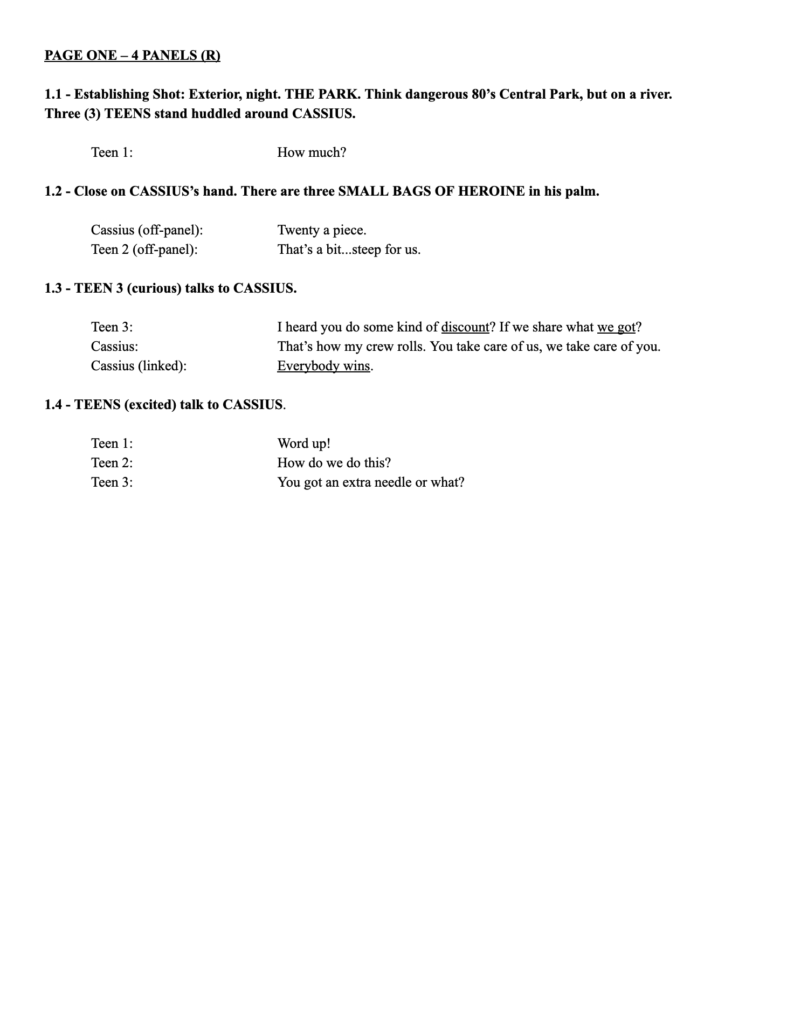Writing a comic book script can seem daunting at first, especially when it comes to formatting. The good news is, there are no strict rules – as long as you and the artist are on the same page, you can use whatever style works best for you. However, it does help to familiarize yourself with some common formats to get started.
How Do You Format a Comic Book Script?
The answer to this questions really comes down to your personal preferences. Do you like to include a lot of detail? Do you like a clean and to-the-point format? Maybe you don’t know yet. The one sure way to find out, though, is to study other writer’s scripts to see what works for you. But before you can do that, you need to know about the types of comic book script formats.
Types of Comic Book Scripts
Let’s start with the the two main types of comic scripts. They are:
- Plot Script – A detailed story outline that the artist then breaks down into panels and pages. Dialogue may be included upfront or added later.
- Full Script – Where every panel, dialogue line, and page is clearly described. This looks the most like a screenplay or stage play format.
To help you find a format that suits your writing style, here are six examples that are great for beginners:
Marvel Method
Popularized by Stan Lee in the 1960’s, the Marvel Method is plot script and more of a freeform approach to comic script writing. It, essentially, consists of a few paragraphs detailing the plot of the issue and leaves the rest in the hands of the artist. These days, Marvel Method scripting is rare, but some modern writers, like Dan Slott, do still use it.

How to Use This Script Format
Start by writing out a detailed story outline or summary, without worrying about page or panel breakdowns. You can include dialogue in the outline or add it later after the artist has drawn the pages. This format puts more of the storytelling responsibility on the artist, so clear communication is key.
Screenplay Format
If you’re familiar with writing movie scripts, the screenplay format for comic books will feel very natural. A number of professional comic book writers work in this format, including the prolific writer of Jessica Jones, New Avengers, Ultimate Spider-Man, and many more modern classics — Brian Bendis. Let’s take a look at a sample page from Bendis’ script for Powers (vol. 2) #1:

How to Use This Script Format
Start with a page and panel number, followed by a description of the visual elements. Dialogue and captions are centered on the page below the description. Keep in mind that comic book dialogue tends to be shorter than film dialogue. Conventional wisdom says to keep the number of words to no more than you can say in a breath (somewhere in the 20-25 words range).
Dark Horse Format
The Dark Horse format is one of the simplest ways to get started with comic script writing. All you need is a basic word processor like Microsoft Word or Google Docs. Here’s what the Dark Horse format looks like:

How to Use This Script Format
Begin by clearly labeling each page and panel number, followed by a concise description of what’s happening in the panel. Dialogue and captions are then written underneath. Dark Horse provides a free formatting guide on their website to help you get started.
Comics Experience Format
The Comics Experience format, developed by Paul Allor and based on editor Andy Schmidt’s style, is another straightforward option that can be done in any word processor.

How to Use This Script Format
Begin with the page and panel numbers, then write out the description, dialogue, and captions in a clear, easy-to-read format. Comics Experience offers classes and workshops that can provide more in-depth guidance on using this style.
I have taken several Comics Experience courses and cannot recommend them enough. Before developing my own script format (more on that below), this is the template I worked from and it’s great for beginners.
Fred Van Lente’s Format
Fred Van Lente’s format is a clean, modern approach that combines elements from various styles. It can be set up in a word processor with auto-numbering for dialogue to keep things organized.

How to Use This Script Format
Start with the page and panel numbers, followed by panel descriptions, dialogue, and captions. You can download the script template here or check out this article for a more in-depth look at the elements of this format.
Frank Gogol Format
Over the years, I have tried variations of all the script formats above, and while each has its merits, they all fell a bit short for me. At the end of the day, a script is a set of instructions you create for your collaborators, especially the artist, and you want to create a document that is both clear and concise. Here’s a look at my comic book script format:

For me, economy is the best policy. The best comic book script format should use the minimum space and number of words to create a clear vision of what should end up on the comic page.
Whenever I script a page, my goal is to always keep one page of comics to one pages of script. That way the artist can see the whole of the page — all the panels, all the dialogue and SFX — at once, rather than looking back and forth between multiple pages.
There are a few elements of my script format that help do that:
Panel Number Shorthand
One way I tighten up the script pages is by using numbered shorthand (1.1, 1.2, and so on) rather than writing “panel” every time there’s a new panel. When reviewing a script or an artists pencils, this makes communication quicker and simpler.
Wider Margins for Panel Descriptions
I also use wider margins than most scripts, which helps keep panel descriptions to 1-2 lines, at most, unless absolutely impossible. Panel descriptions go on the same line as the panel number. This is a minor script optimization, but also it saves space.
Restricted Dialogue Space
Whenever a character speaks, I indent once, write the character’s name followed by colon, then I ident three more times. The space that is left from that point to the right margin is where the dialogue for a single word balloon must fit. Limiting the space I allow for myself to write dialogue ensures that every word counts and that I am being succinct.

Important:
One additional item that helps with clarity, but not necessarily brevity — At the very top of every page of my script, I note whether a page is left-facing (L) or right-facing (R). Left or right matters when it comes to page turns, creating narrative momentum, and reveals, yet almost none of the well-known script formats denote this aspect of the page.
Ultimately, I think, these comic book script format optimizations make for a neater, more readable script, which will help your artist bring your story to life.
All you have to do is sign up for the Effigies newsletter:
Even More Comic Book Script Formats
If none of the common comic book script formats above speak to you, you’re in luck. There are plenty of other formats to choose from. Check out Comics Experience’s Comic Book Scripts page to find script templates from some of the industry’s notable names, including Jason Aaron, Cullen Bunn, Neil Gaiman, and more.
Read Next
Choosing a script format is just your first step. It determines the general structure of your script template. Once you know your format, you need to understand the various elements that make up your script format and how to use them. To diver deeper into the parts of a script read, check out our guide on the parts of a comic book script next.
Final Thoughts
The best way to learn is by example. Read as many professional comic scripts as you can to see how writers structure pages, panels, scenes, and stories. The Comic Book Script Archive is an excellent resource for finding scripts by established writers.
Remember, there’s no universally correct way to format a comic script. Use these examples as a starting point to develop a style and system that works for you and your collaborators. The most important thing is to clearly communicate your vision to the artist to bring your story to life on the page. Happy writing!
The Gentleman’s Agreement
If you read this post and got some value from it, do me a solid and subscribe to my newsletter below. It costs nothing and it’s where I do interesting writing, anyway.
Frank Gogol is a San Francisco-based comic book writer. He is the writer of Dead End Kids (2019), GRIEF (2018), No Heroine (2020), Dead End Kids: The Suburban Job (2021), and Unborn (2021) as well as his work on the Power Rangers franchise.
Gogol’s first book, GRIEF, was nominated for the Ringo Award for Best Anthology in 2019. Gogol and his second book, Dead End Kids, were named Best Writer and Best New Series of 2019, respectively, by the Independent Creator Awards.
